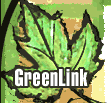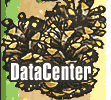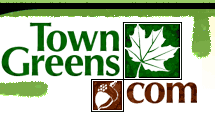The Brooklyn Green is the heart of the Brooklyn Green National Register Historic District. It is roughly a 1.75 acre square bounded on all four sides by streets as well as being diagonally crossed by them, thereby dividing it into four triangles. As a result, the dominant features of the green are the roads as well as the single building on the largest and eastern most triangulated-parcel; the impressive meetinghouse built in 1771 and well documented in Kelly's "Early Connecticut Meeting Houses."
The roads that border and cut across the green are a result of (1) Route 169 (Canterbury Road) that comes from the south and meets the green at the southeast corner, forms the eastern boundary and continues north to Pomfret as Pomfret Road and Route 169; (2) heavily traveled Route 6 that approaches the green from the southwest, cuts diagonally through it, then continues northeast to Providence; (3) and Wolf Den Road that comes from the northwest and divides at the corner to become two roads, one that forms the northern boundary and one that cuts diagonally through it.
It is suffice to say that the Brooklyn Green is the nexus for the flow of traffic through Brooklyn and while it derives much of its character from that role, it also suffers from it. It is too small to act as a buffer for the traffic created mainly by Route 6, a major state highway, and Route 169. With all the activity, it is difficult to comprehend the green as square. One tends to view it as four separate pieces.
A few sugar maple trees have been planted primarily along the northern and eastern boundaries and a hemlock tree is located near the northeast intersection. Other than the trees, the town pump (shelter dates from 1911) sited between the hemlock tree and the intersection, and four green wooden benches, the green remains relatively bare. There are no paths and curbs existing, only along Route 6. The edges of the rest of the green are generally several inches above the road, creating a natural curb and conveying the feeling that the roads around and through the green are well-worn and are naturally occurring phenomenon (to the extent possible given the high level of traffic).
There are no memorials on the green. These are placed along Route 169 just south of the green on the west side of the road in a commercial area about 70 to 100 feet apart. There are three large ones: one in memory of those who fought in the Civil War; one honoring those who were in the other U.S. wars; and one in commemorating Israel Putnam (1888), a prominent local citizen who fought for the British during the wars against the French and in the Revolutionary War. The base of the monument is a sarcophagus containing Putnam's remains.
As the earliest area of settlement in Brooklyn and the town center, the greatest concentration of buildings exists around the green. Surrounding it are two other churches (in addition to the early meetinghouse on the green), the town hall, library, and residences dating primarily from the last half of the 18th century and the first half of the 19th century. The meetinghouse is the dominant building in the town center, but the Town Hall (1820), formerly the Windham County Courthouse, is also prominent. The two-story structure built in the Greek Revival style sits close to the road at the northeast corner. The two other churches, Trinity Episcopal (1866) and Federated Church of Christ (1871) are set back from the green and are not as visible.
All the buildings with the exception of the house on the southeast corner (built ca. 1760, rebuilt ca. 1880) are facing the green and clearly relate to it as an important space. The three early houses along Putnam Place are spaced closely together and an even distance from the road and, as a result, provide it with definite boundaries by creating an obvious enclosure. The other buildings surrounding it are on larger lots and do not provide the green with as great a feeling of enclosure.
The Society owns a wedge of land along the southern boundary that is not included in the green, indicating that the green was larger than it is today.






![]()